Improving Mildew Resistance of Soy Meal by Nano-Ag/TiO2, Zinc Pyrithione and 4-Cumylphenol
Abstract
1. Introduction
2. Materials and Methods
2.1. Materials
2.2. Adhesive Preparation
2.3. Observation of Preservative-Treated SM
2.4. Solid Content
2.5. Fourier Transform Infrared (FTIR) Spectroscopy
2.6. Thermogravimetry (TG)
2.7. Scanning Electron Microscopy (SEM)
3. Results and Discussion
3.1. Evaluation of Mold Resistance for Preservative-Treated SM
3.2. SEM Analysis of the Adhesives
3.3. Solid Content and Initial Viscosity
3.4. FTIR Analysis
3.5. Thermal Stability Measurements
4. Conclusions
Author Contributions
Funding
Acknowledgments
Conflicts of Interest
References
- Li, R.J.; Gutierrez, J.; Chung, Y.L.; Frank, C.W.; Billington, S.L.; Sattely, E.S. A Lignin-Epoxy Resin Derived from Biomass as An Alternative to Formaldehyde-Based Wood Adhesives. Green Chem. 2018, 20, 1459–1466. [Google Scholar] [CrossRef]
- Pizzi, A.; Mittal, K.L. Handbook of Adhesive Technology, 3rd ed.; CRC Press: Boca Raton, FL, USA, 2018; pp. 145–201. [Google Scholar]
- Roffael, E. Volatile organic compounds and formaldehyde in nature, wood and wood based panels. Holz Roh-Werkst. 2006, 64, 144–149. [Google Scholar] [CrossRef]
- Lin, H.; Gunasekaran, S. Cow blood adhesive: Characterization of physicochemical and adhesion properties. Int. J. Adhes. Adhes. 2010, 30, 139–144. [Google Scholar] [CrossRef]
- Zhao, S.S.; Xing, F.R.; Wang, Z.; Kang, H.J.; Zhang, S.F.; Li, J.Z. High bonding strength and boiling water resistance of soy protein-based adhesives via organosilicon-acrylate microemulsion and epoxy synergistic interfacial enhancement. J. Appl. Polym. Sci. 2018, 135, 46061. [Google Scholar] [CrossRef]
- Zhang, M.; Zhang, Y.; Chen, M.S.; Gao, Q.; Li, J.Z. A High-Performance and Low-Cost Soy Flour Adhesivewith a Hydroxymethyl Melamine Prepolymer. Polymers 2018, 10, 909. [Google Scholar] [CrossRef]
- Chen, Q.; Liu, Y.; Chen, G. A comparative study on the starch-based biocomposite films reinforced by nanocellulose prepared from different non-wood fibers. Cellulose 2019, 26, 2425–2435. [Google Scholar] [CrossRef]
- Sulaiman, N.S.; Hashim, R.; Sulaiman, O.; Nasir, M.; Amini, M.H.H.; Hizirogliu, S. Partial replacement of urea-formaldehyde with modified oil palm starch based adhesive to fabricate particleboard. Int. J. Adhes. Adhes. 2018, 84, 1–8. [Google Scholar] [CrossRef]
- Wang, Z.; Li, Z.; Gu, Z.; Hong, Y.; Cheng, L. Preparation, characterization and properties of starch-based wood adhesive. Carbohydr. Polym. 2012, 88, 699–706. [Google Scholar] [CrossRef]
- Ghahri, S.; Pizzi, A. Improving soy-based adhesives for wood particleboard by tannins addition. Wood Sci. Technol. 2018, 52, 261–279. [Google Scholar] [CrossRef]
- Moubarik, A.; Charrier, B.; Allal, A.; Charrier, F.; Pizzi, A. Development and optimization of a new formaldehyde-free cornstarch and tannin wood adhesive. Eur. J. Wood Wood Prod. 2010, 68, 167–177. [Google Scholar] [CrossRef]
- Widyorini, R.; Umemura, K.; Isnan, R.; Putra, D.R.; Awaludin, A.; Prayitno, T.A. Manufacture and properties of citric acid-bonded particleboard made from bamboo materials. Eur. J. Wood Wood Prod. 2016, 74, 57–65. [Google Scholar] [CrossRef]
- Umemura, K.; Ueda, T.; Munawar, S.S.; Kawai, S. Application of citric acid as natural adhesive for wood. J. Appl. Polym. Sci. 2011, 123, 1991–1996. [Google Scholar] [CrossRef]
- Zhang, Y.; Zhang, M.; Chen, M.; Luo, J.; Li, X.; Gao, Q.; Li, J. Preparation and characterization of a soy protein-based high-performance adhesive with a hyperbranched cross-linked structure. Chem. Eng. J. 2018, 354, 1032–1041. [Google Scholar] [CrossRef]
- Vnucec, D.; Kutnar, A.; Gorsek, A. Soy-based adhesives for wood-bonding—A review. J. Adhes. Sci. Technol. 2017, 31, 910–931. [Google Scholar] [CrossRef]
- Lei, H.; Du, G.; Wu, Z.; Xi, X.; Dong, Z. Cross-linked soy-based wood adhesives for plywood. Int. J. Adhes. Adhes. 2014, 50, 199–203. [Google Scholar] [CrossRef]
- Kaufert, F.H.; Blew, J.O. Experiments with Preservatives for Soybean Glue and Soybean-Glued Plywood; US Department of Agriculture, Forest Service, Forest Products Laboratory: Madison, WI, USA, 1962; pp. 1–15.
- Xing, F.; Chen, H.; Zhang, S.F.; Luo, B.; Fang, P.; Li, L.; Li, J.Z. Effect of p-Cumylphenol on the Mold Resistance of Modified Soybean Flour Adhesive and Poplar Plywood. BioResources 2015, 10, 1543–1552. [Google Scholar] [CrossRef]
- Shen, Z.-Q.; Wang, F. Study on the Aryl-alkylation of Phenol with alpha-Methylstyrene. Chin. J. Synth. Chem. 2006, 14, 196. [Google Scholar]
- Chaudhuri, B.; Sharma, M.M. Alkylation of phenol with α-methylstyrene, propylene, butenes, isoamylene, 1-octene, and diisobutylene: Heterogeneous vs. homogeneous catalysts. Ind. Eng. Chem. Res. 1991, 30, 227–231. [Google Scholar] [CrossRef]
- Özdemir, G.; Limoncu, M.H.; Yapar, S. The antibacterial effect of heavy metal and cetylpridinium-exchanged montmorillonites. Appl. Clay Sci. 2010, 48, 319–323. [Google Scholar] [CrossRef]
- Zivic, F.; Grujovic, N.; Mitrovic, S.; Ahad, I.U.; Brabazon, D. Characteristics and Applications of Silver Nanoparticles. In Commercialization of Nanotechnologies–A Case Study Approach; Brabazon, D., Pellicer, E., Eds.; Springer: Gewerbestrasse, Switzerland, 2018; pp. 227–273. [Google Scholar]
- Vijayalakshmi, K.; Sivaraj, D. Synergistic antibacterial activity of barium doped TiO2 nanoclusters synthesized by microwave processing. RSC Adv. 2016, 6, 9663–9671. [Google Scholar] [CrossRef]
- Barzman, M. Eight principles of integrated pest management. Agron. Sustain. Dev. 2015, 35, 1199–1215. [Google Scholar] [CrossRef]
- Lee, W.S.; Park, Y.-S.; Cho, Y.-K. Significantly enhanced antibacterial activity of TiO2 nanofibers with hierarchical nanostructures and controlled crystallinity. Analyst 2015, 140, 616–622. [Google Scholar] [CrossRef] [PubMed]
- Fu, G.; Vary, P.S.; Lin, C.T. Anatase TiO2 nanocomposites for antimicrobial coatings. J. Phys. Chem. B 2005, 109, 8889–8898. [Google Scholar] [CrossRef]
- Huang, B.; Saka, S. Photocatalytic activity of TiO 2 crystallite-activated carbon composites prepared in supercritical isopropanol for the decomposition of formaldehyde. J. Wood Sci. 2003, 49, 0079–0085. [Google Scholar] [CrossRef]
- McEvoy, J.G.; Zhang, Z. Antimicrobial and photocatalytic disinfection mechanisms in silver-modified photocatalysts under dark and light conditions. J. Photochem. Photobiol. C 2014, 19, 62–75. [Google Scholar] [CrossRef]
- Albert, E.; Hórvölgyi, Z.; Albouy, P. Antibacterial properties of Ag-TiO2 composite sol-gel coatings. RSC Adv. 2015, 5, 59070–59081. [Google Scholar] [CrossRef]
- Chandler, C.J.; Segel, I.H. Mechanism of the antimicrobial action of pyrithione: Effects on membrane transport, ATP levels, and protein synthesis. Antimicrob. Agents Chemother. 1978, 14, 60–68. [Google Scholar] [CrossRef]
- Yeung, R.C.Y.; Lam, S.Y.; Wong, K.-B. Crystallization and preliminary crystallographic analysis of human common-type acylphosphatase. Acta Crystallogr. Sect. F Struct. Biol. Cryst. Commun. 2005, 62, 80–82. [Google Scholar] [CrossRef]
- Li, K.; Li, X.; Luo, J.; Li, J.; Gao, Q.; Li, J. A Highly Water-Resistant Soy-Based Bioadhesive with 1,4-Butanediol Diglycidyl Ether and its Application on Plywood. J. Renew. Mater. 2017, 5, 31–38. [Google Scholar] [CrossRef]
- Lin, L.; Yang, Y.; Brian, K.; Liu, Y.; Guo, H.W.; Zhang, F. Modification and Characterization of Nano-Ag/TiO2 Antimold Agent for Wood Materials. For. Prod. J. 2018, 68, 70–77. [Google Scholar]
- She, J.; Tian, C.; Wu, Y.; Li, X.; Luo, S.; Qing, Y.; Jiang, Z. Cellulose Nanofibrils Aerogel Cross-Linked by Poly (vinyl alcohol) and Acrylic Acid for Efficient and Recycled Adsorption with Heavy Metal Ions. J. Nanosci. Nanotechnol. 2018, 18, 4167–4175. [Google Scholar] [CrossRef] [PubMed]
- Yu, Y.; Bala, H.; Xu, C. Progress on surface modification of nano-titania. Inorg. Chem. Ind. 2008, 40, 11–13. [Google Scholar]
- Chen, S. Nano-silica Coupled by Silicane Coupling Agent Modified Shape Memory Polyurethane. PU Ind. 2005, 20, 26–29. [Google Scholar]
- Marques, H.M.C. A review on cyclodextrin encapsulation of essential oils and volatiles. Flavour Fragr. J. 2010, 25, 313–326. [Google Scholar] [CrossRef]
- Sivarooban, T.; Hettiarachchy, N.S.; Johnson, M.G. Physical and antimicrobial properties of grape seed extract, nisin, and EDTA incorporated soy protein edible films. Food Res. Int. 2008, 41, 781–785. [Google Scholar] [CrossRef]
- Kaufert, F.H.; Blew, J.O. Increasing the Durability of Casein Glue Joints with Preservatives; US Department of Agriculture, Forest Service, Forest Products Laboratory: Madison, WI, USA, 1963; pp. 1–17.
- Satasivam, S.; Bai, Y.; Yang, Y.; Zhu, L.; Zhao, X.-L. Mechanical performance of two-way modular FRP sandwich slabs. Compos. Struct. 2018, 184, 904–916. [Google Scholar] [CrossRef]
- Li, J.; Zhang, B.; Li, X.; Yi, Y.; Shi, F.; Guo, J.; Gao, Z. Effects of typical soybean meal type on the properties of soybean-based adhesive. Int. J. Adhes. Adhes. 2019, 90, 15–21. [Google Scholar] [CrossRef]
- Luo, J.; Li, X.; Zhang, H.; Gao, Q.; Li, J. Properties of a soybean meal-based plywood adhesive modified by a commercial epoxy resin. Int. J. Adhes. Adhes. 2016, 71, 99–104. [Google Scholar] [CrossRef]
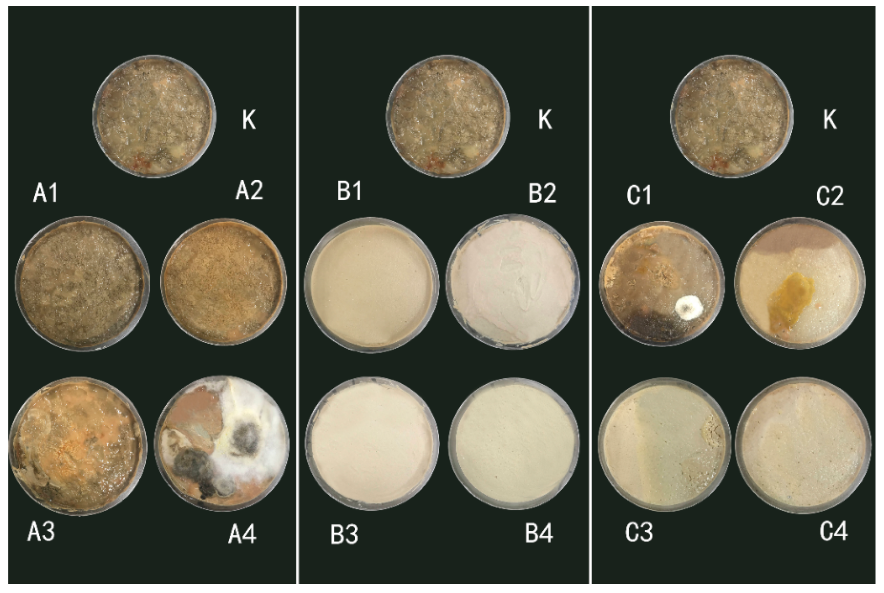
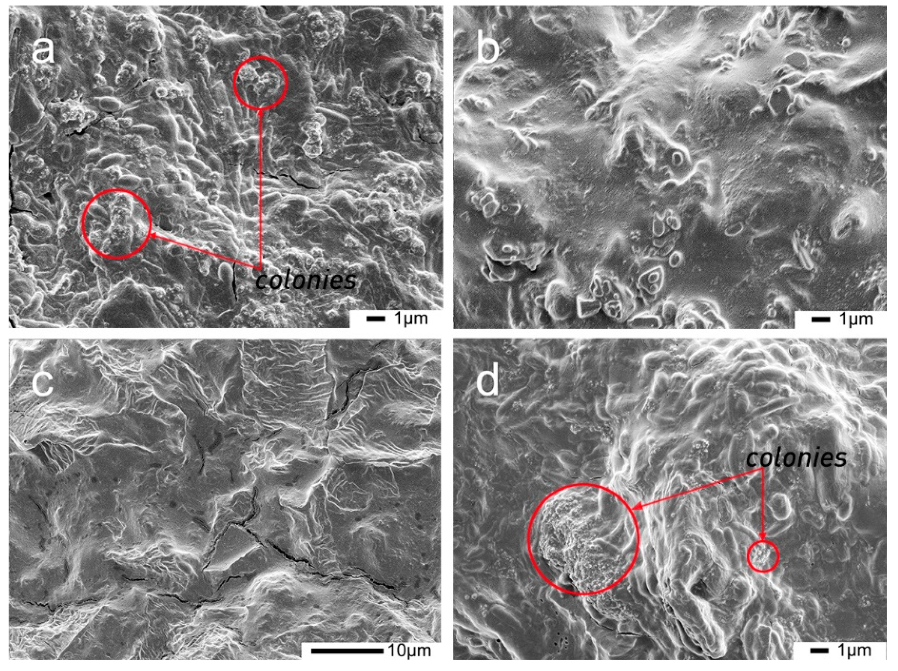
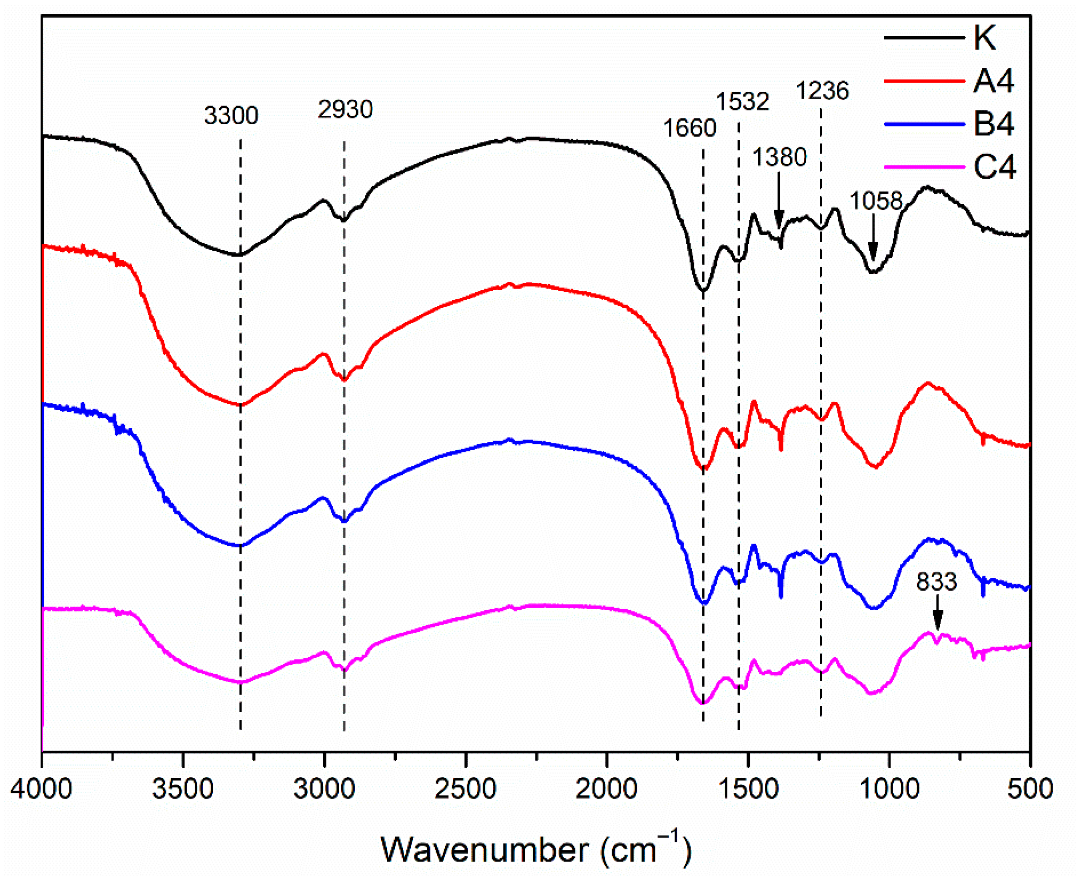
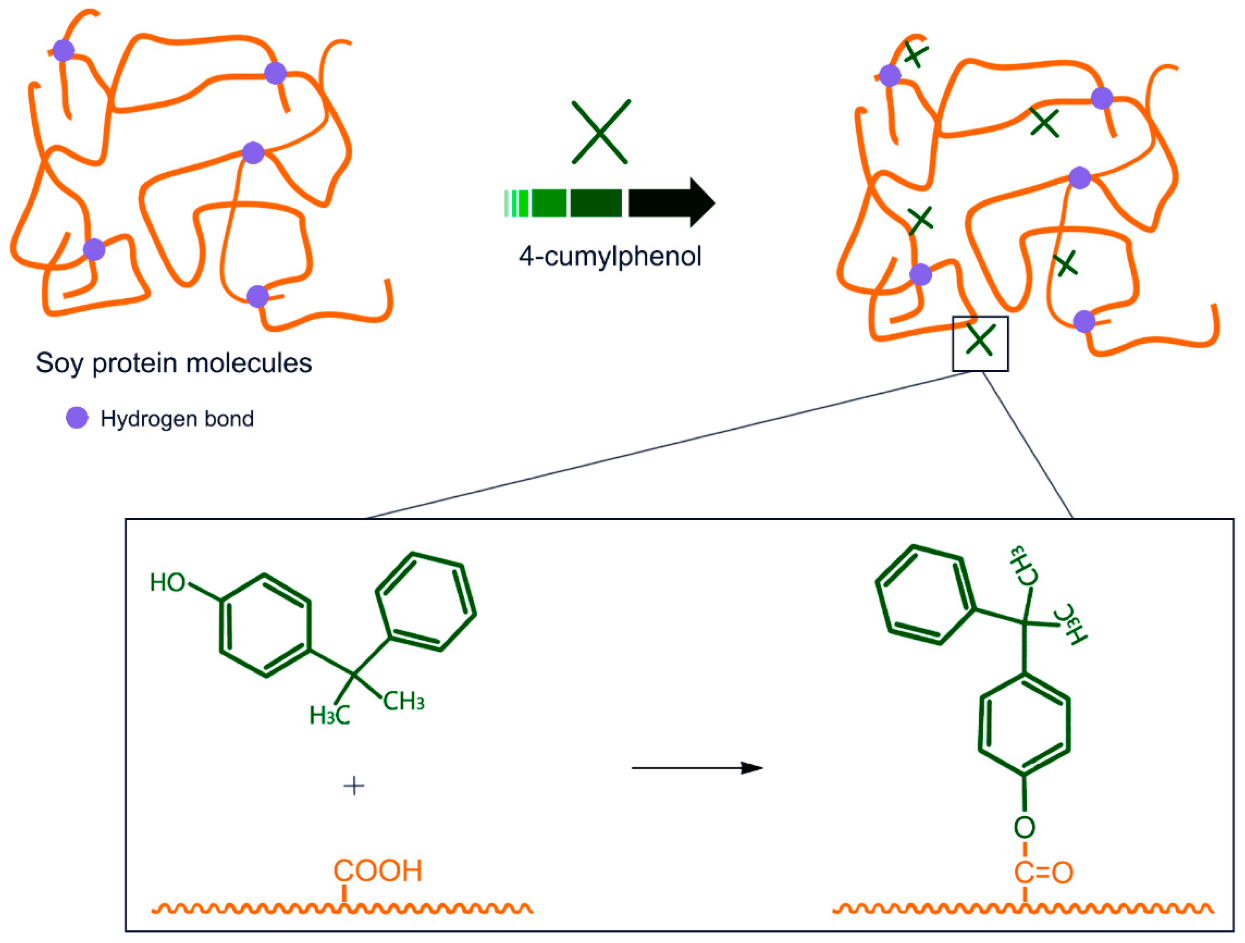
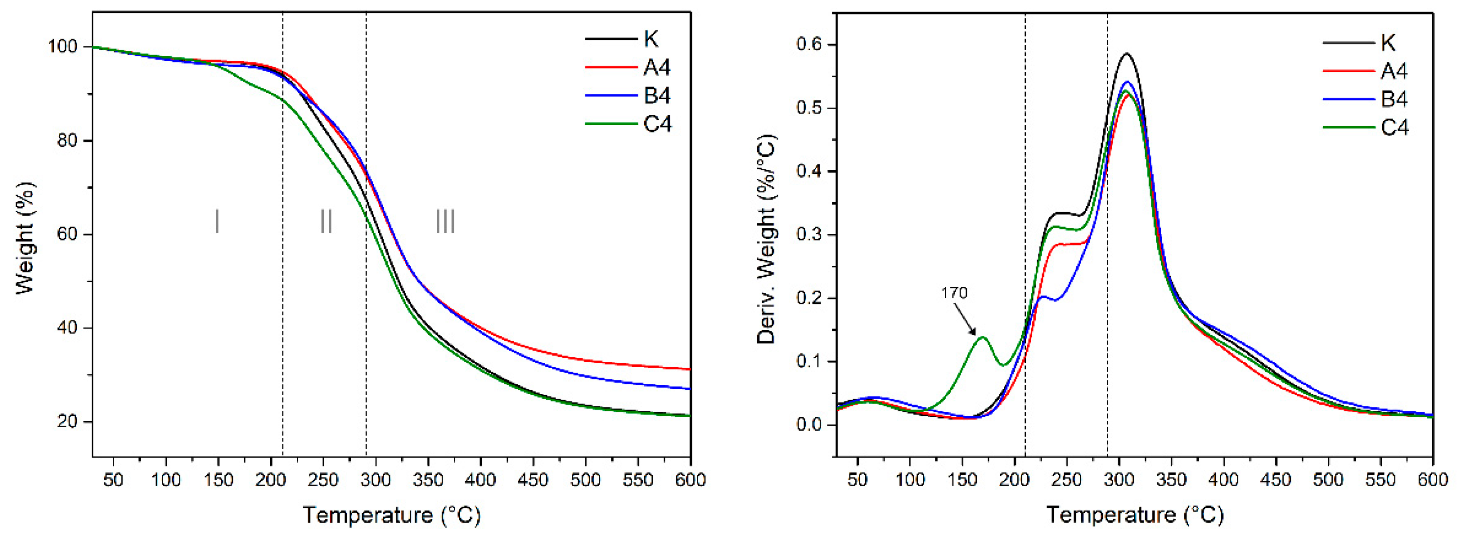

| Sample Number | Type of Preservative | Amount of Preservative(g) |
|---|---|---|
| K | — | — |
| A1 | Nano-Ag/TiO2 | 0.5 |
| A2 | Nano-Ag/TiO2 | 1 |
| A3 | Nano-Ag/TiO2 | 2 |
| A4 | Nano-Ag/TiO2 | 3 |
| B1 | Nano-Ag/TiO2 & ZPT | 0.5 |
| B2 | Nano-Ag/TiO2 & ZPT | 1 |
| B3 | Nano-Ag/TiO2 & ZPT | 2 |
| B4 | Nano-Ag/TiO2 & ZPT | 3 |
| C1 | 4-Cumylphenol | 0.5 |
| C2 | 4-Cumylphenol | 1 |
| C3 | 4-Cumylphenol | 2 |
| C4 | 4-Cumylphenol | 3 |
| Time (Day) | Degree of Mold Growth | ||||||||||||
|---|---|---|---|---|---|---|---|---|---|---|---|---|---|
| K | A1 | A2 | A3 | A4 | B1 | B2 | B3 | B4 | C1 | C2 | C3 | C4 | |
| 1 | + | ||||||||||||
| 2 | ++ | ++ | ++ | + | + | ||||||||
| 3 | +++ | +++ | +++ | +++ | + | ||||||||
| 4 | ++++ | ++++ | ++++ | ++++ | + | + | + | ||||||
| 5 | +++++ | +++++ | +++++ | +++++ | + | ++ | + | ||||||
| 6 | +++++ | +++++ | +++++ | +++++ | ++ | ++ | + | ||||||
| 7 | +++++ | +++++ | +++++ | +++++ | +++ | +++ | + | ||||||
| 8 | +++++ | +++++ | +++++ | +++++ | ++++ | ++++ | + | ||||||
| 9 | ++++++ | ++++++ | ++++++ | ++++++ | ++++ | +++++ | + | ||||||
| 10 | ++++++ | ++++++ | ++++++ | ++++++ | +++++ | ++++++ | + | ||||||
| 11 | ++++++ | ++++++ | ++++++ | ++++++ | +++++ | ++++++ | + | ||||||
| 12 | ++++++ | ++++++ | ++++++ | ++++++ | +++++ | ++++++ | + | ||||||
| 13 | ++++++ | ++++++ | ++++++ | ++++++ | +++++ | ++++++ | + | ||||||
| 14 | ++++++ | ++++++ | ++++++ | ++++++ | ++++++ | ++++++ | + | ||||||
| 15 | ++++++ | ++++++ | ++++++ | ++++++ | ++++++ | ++++++ | + | ||||||
| Adhesive Code | |||||||||||||
|---|---|---|---|---|---|---|---|---|---|---|---|---|---|
| K | A1 | A2 | A3 | A4 | B1 | B2 | B3 | B4 | C1 | C2 | C3 | C4 | |
| Solid content(%) | 26.77 | 26.91 | 27.15 | 27.32 | 27.46 | 27.12 | 27.42 | 27.68 | 27.83 | 26.83 | 26.85 | 27.45 | 27.61 |
| Initial viscosity (mPa·s) | 38,432 | 31,063 | 30,913 | 30,471 | 30,226 | 49,697 | 50,149 | 50,685 | 51,092 | 34,193 | 37,152 | 37,639 | 38,273 |
© 2020 by the authors. Licensee MDPI, Basel, Switzerland. This article is an open access article distributed under the terms and conditions of the Creative Commons Attribution (CC BY) license (http://creativecommons.org/licenses/by/4.0/).
Share and Cite
Li, W.; Chen, M.; Li, Y.; Sun, J.; Liu, Y.; Guo, H. Improving Mildew Resistance of Soy Meal by Nano-Ag/TiO2, Zinc Pyrithione and 4-Cumylphenol. Polymers 2020, 12, 169. https://doi.org/10.3390/polym12010169
Li W, Chen M, Li Y, Sun J, Liu Y, Guo H. Improving Mildew Resistance of Soy Meal by Nano-Ag/TiO2, Zinc Pyrithione and 4-Cumylphenol. Polymers. 2020; 12(1):169. https://doi.org/10.3390/polym12010169
Chicago/Turabian StyleLi, Wenping, Mingsong Chen, Yanchen Li, Jingmeng Sun, Yi Liu, and Hongwu Guo. 2020. "Improving Mildew Resistance of Soy Meal by Nano-Ag/TiO2, Zinc Pyrithione and 4-Cumylphenol" Polymers 12, no. 1: 169. https://doi.org/10.3390/polym12010169
APA StyleLi, W., Chen, M., Li, Y., Sun, J., Liu, Y., & Guo, H. (2020). Improving Mildew Resistance of Soy Meal by Nano-Ag/TiO2, Zinc Pyrithione and 4-Cumylphenol. Polymers, 12(1), 169. https://doi.org/10.3390/polym12010169






